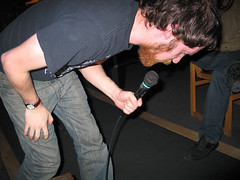Schrodinger's cat
A cat is placed in a box, together with a radioactive atom. If the atom decays, a hammer kills the cat; if the atom doesn't decay, the cat lives. As the atom is considered to be in either state before the observer opens the box, the cat must thus be considered to be simultaneously dead and alive.
- Erwin Schrodinger's Cat Paradox, 1935
- Erwin Schrodinger's Cat Paradox, 1935



2 Comments:
"According to classical physics, the cat is either dead or it is not dead. All that we have to do is to open the box and see which is the case. According to quantum mechanics, the situation is not so simple.
The Copenhagen Interpretation of Quantum Mechanics says that the cat is in a kind of limbo represented by a wave function which contains the possibility that the cat is dead and also the possibility that the cat is alive. when we look in the box, and not before, one of these possibilities actualizes and the other vanishes. This is known as the collapse of the wave function because the hump in the wave function representing the possibility what did not occur, collapses. It is necessary to look into the box before either possibility can occur. Until then, there is only a wave function.
Of course, this does not not make sense. Experience tells us that a cat is what we put into the box and a cat is still what is inside the box, it makes no difference as far as the cat is concerned. Its fate was decided at the beginning of the experiment.
This commonsense view is also the view of classical physics, we get to know something by observing it. According to quantum mechanics, it isn't there until we do observe it! Therefore, the fate of the cat is not determined until we look inside the box.
The Many Worlds Interpretation of Quantum Mechanics and the Copenhagen Interpretation of Quantum Mechanics agree that the fate of the cat is not determined for us until we look inside the box, however, depends upon which interpretation we choose to follow. According to the Copenhagen Interpretation, at the instant that we look inside the box, one of the possibilities contained in the wave function representing the cat actualizes and the other possibility vanishes. The cat is either dead or alive.
According to the Many Worlds Interpretation, at the instant that the atom decays (or doesn't decay, depending upon which branch of reality we are talking about), the world splits into two branches, one associated with the branch of reality in which the cat is dead and one associated with the branch of reality in which the cat is alive. Neither consciousness is aware of the other."
- Gary Zukov.
I transcribed the above passage with a mistake of one letter. My deepest apologies. I'm pretty drunk. The correct passage is as follows:
"According to classical physics, the cat is either dead or it is not dead. All that we have to do is to open the box and see which is the case. According to quantum mechanics, the situation is not so simple.
The Copenhagen Interpretation of Quantum Mechanics says that the cat is in a kind of limbo represented by a wave function which contains the possibility that the cat is dead and also the possibility that the cat is alive. when we look in the box, and not before, one of these possibilities actualizes and the other vanishes. This is known as the collapse of the wave function because the hump in the wave function representing the possibility that did not occur, collapses. It is necessary to look into the box before either possibility can occur. Until then, there is only a wave function.
Of course, this does not not make sense. Experience tells us that a cat is what we put into the box and a cat is still what is inside the box, it makes no difference as far as the cat is concerned. Its fate was decided at the beginning of the experiment.
This commonsense view is also the view of classical physics, we get to know something by observing it. According to quantum mechanics, it isn't there until we do observe it! Therefore, the fate of the cat is not determined until we look inside the box.
The Many Worlds Interpretation of Quantum Mechanics and the Copenhagen Interpretation of Quantum Mechanics agree that the fate of the cat is not determined for us until we look inside the box, however, depends upon which interpretation we choose to follow. According to the Copenhagen Interpretation, at the instant that we look inside the box, one of the possibilities contained in the wave function representing the cat actualizes and the other possibility vanishes. The cat is either dead or alive.
According to the Many Worlds Interpretation, at the instant that the atom decays (or doesn't decay, depending upon which branch of reality we are talking about), the world splits into two branches, one associated with the branch of reality in which the cat is dead and one associated with the branch of reality in which the cat is alive. Neither consciousness is aware of the other."
- Gary Zukov.
11:38 PM
Delete
Post a Comment
<< Home